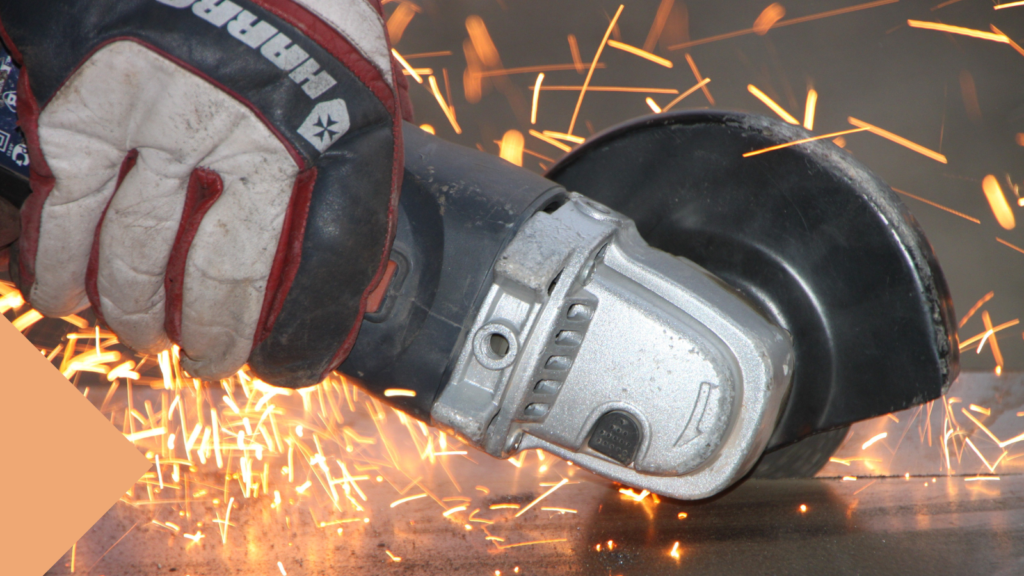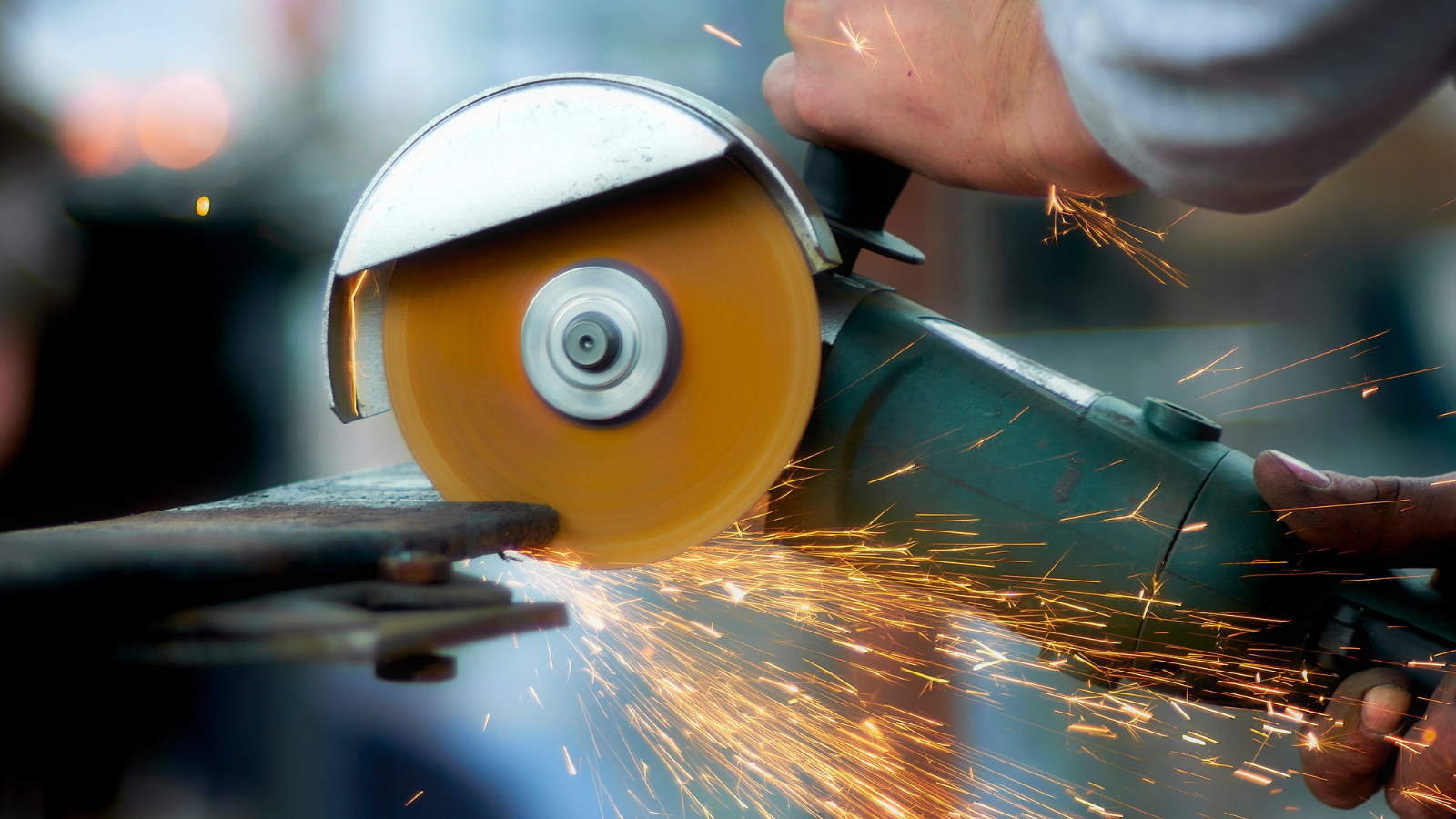An angle grinder is a game-changer. The first time I used one, I just wanted to cut a rusty bolt. But I quickly saw it could do much more! It slices metal, smooths rough edges, and even sharpens tools. What can you do with an angle grinder? A lot! In this guide, I’ll show you its best uses and share easy tips to help you get started. Let’s go!
Understanding the Angle Grinder
What is an Angle Grinder?
An angle grinder is a handheld tool that cuts, grinds, and polishes. It spins a disc at high speed to handle tough jobs fast. Think of it as a power tool that does it all! Whether cutting metal or smoothing rough edges, it makes work quick and easy.
Types of Angle Grinders
There are two main types: corded and cordless.
- Corded grinders have steady power, which is excellent for big jobs.
- Cordless grinders are battery-powered, giving you more freedom to move.
They also come in different sizes. Small ones (like 4.5-inch models) are perfect for DIY projects, while larger ones (9-inch models) are better for heavy-duty work. Bigger grinders have more power, but they can be harder to handle.
Essential Parts of an Angle Grinder
Knowing the parts helps you use it safely and get the best results:
- Discs – Different discs do different jobs. Cutting wheels slice through metal, grinding discs smooth surfaces, and flap discs polish.
- Motor Power – More power means faster cutting. High-power grinders cut metal, while lower-power ones work best for light tasks.
- Handles & Safety Guards – The side handle helps with control, and the safety guard protects you from sparks and debris. Never remove the guard—it’s there to keep you safe!
An angle grinder may seem tricky initially, but once you know how it works, it’s a must-have tool. Ready to see what it can do? Let’s jump into its top uses!

Top Uses for an Angle Grinder
An angle grinder is a handy tool that cuts, grinds, polishes, and sharpens. It works on metal, wood, and stone. Let’s explore its best uses.
Cutting Applications
Cutting is one of the main jobs of an angle grinder. It makes slicing through tough materials quick and easy.
- Cutting Steel & Metal – Need to trim a metal pipe or remove a bolt? A thin cutting disc works best. Hold the grinder steady and let the blade do the work—no need to force it.
- Cutting Concrete, Tile, and Brick – A diamond blade can slice through hard materials. Move the grinder slowly to avoid overheating.
- Cutting Wood and Plastic – While not the first choice for wood, an angle grinder can cut it with the right disc. Be careful—wood burns easily and can kick back.
Grinding and Smoothing
This tool is great for cleaning up rough or rusty surfaces.
- Removing Rust and Paint – A wire brush attachment strips away rust and old paint fast. Perfect for restoring tools or prepping metal for painting.
- Smoothing Welds and Shaping Metal – Welders use grinders to smooth out rough welds. You can also shape metal edges for a better fit.
Polishing and Finishing
Want a smooth, shiny finish? Just switch to a polishing pad.
- Polishing Metal – A polishing wheel makes dull metal shine. Great for tools, car parts, and more.
- Restoring Old Tools – Have rusty pliers or a worn-out wrench? A grinder can make them look brand new.
Sharpening Tools
Keep your tools sharp instead of buying new ones.
- Sharpening Blades and Chisels – A grinding disc makes sharpening fast and easy. Light, even pressure gives the best results.
DIY and Home Projects
Angle grinders aren’t just for metalworkers—they’re great for home repairs too!
- Cutting Pipes for Plumbing – Need to trim a pipe for a sink or shower? A grinder slices through PVC or metal in seconds.
- Prepping Surfaces for Welding or Painting – Smooth rough spots before welding or painting for a pro-level finish.
With so many uses, an angle grinder is a must-have tool. Just choose the right disc, follow safety tips, and let the grinder do the work!
How to Use an Angle Grinder Safely and Effectively
Angle grinders are powerful tools, but they can be risky if you’re not careful. The first time I used one, I was too excited. I gripped it too hard, and the disc caught on the metal, almost jerking out of my hands. I quickly learned to respect the tool. When you handle it correctly, it will work with you. Here’s how to use an angle grinder safely and efficiently.
Choosing the Right Disc for the Job
Not all discs work the same way. Using the wrong disc can slow you down or cause an accident. Here’s what to use for different tasks:
- A thin abrasive disc (1.0–1.6mm) works best for cutting metal.
- For grinding and smoothing, Use a thick or flap disc for metal.
- A diamond blade is your best option for concrete, tile, or brick.
- Use a special carbide-tipped disc for wood or plastic, but avoid using a grinder for wood if you can. Wood can cause kickback.
A good rule is: If the disc is cracked, dull, or wobbles, replace it.
Proper Handling Techniques
An angle grinder is like a dance partner. If you move the right way, everything goes smoothly. Here’s how to handle it:
Use both hands—one hand on the main handle and the other on the side handle for balance.
Start slow – Let the disc reach full speed before cutting.
Let the tool do the work – Don’t force it. Just guide it steady.
Work at the right angle—keep a cutting disc at 90°, a grinding disc at 30°, and a polishing disc flat.
Don’t yank the grinder during cuts. This can cause kickback, and trust me, it’s no fun.
Safety Gear and Precautions
Safety first! You don’t want metal shards flying at your face. Here’s what to wear:
- Eye and ear protection: Safety goggles and earplugs are needed. Grinders are loud and throw sparks.
- Proper clothes and gloves: Wear fitted clothes, no loose sleeves, and heavy-duty gloves for hand protection.
- Work in a well-ventilated area: Grinding creates dust, so avoid working in tight spaces.
Tip: Never remove the safety guard. It’s there to protect you!
Common Mistakes to Avoid
Kickback occurs when the disc gets stuck and jerks the tool. Keep a firm grip to prevent it, and don’t twist the grinder while cutting.
Overloading the motor – Pushing too hard can overheat the grinder. Let it work at its own pace.
Using the wrong disc – Never use a wood disc for metal. Always match the disc to the job.
Ignoring sparks and debris – Sparks can ignite flammable materials. Keep your workspace clear!
Use an angle grinder correctly, and it’ll become your best tool in the workshop. Stay safe, work smart, and let the sparks fly—but not toward your face!

FAQs (Answering Common User Questions)
What is a grinder used for besides cutting?
An angle grinder isn’t just for cutting. It’s super versatile! You can use it to grind, polish, and even sharpen tools. For example, if you have a rusty tool, a grinder with a wire brush attachment can clean it up quickly. I also use it to smooth out metal or shape parts for my projects. One tool with so many uses!
Can you use an angle grinder to cut wood safely?
You can use a grinder to cut wood, but be careful. Wood can cause the tool to kick back, which could be dangerous. To do it safely, use a carbide-tipped disc made of wood. I’ve used my grinder for smaller wood projects but wouldn’t use it for significant cuts. Just wear safety gear and be mindful of the risk.
How long do angle grinder discs last?
How long a disc lasts depends on what you’re cutting. For light tasks, it might last a while. But if you’re doing heavy work, it can wear out faster. I check my discs often. If they get cracked or too dull, I replace them. A worn-out disc won’t work well and could be dangerous.
What’s the best angle grinder for beginners?
For beginners, I recommend a 4.5-inch corded grinder. It’s small and easy to control. It’s perfect for most home DIY projects. Look for one with adjustable speeds to control the power for different jobs. I started with one of these, and it was perfect for learning the ropes.
How do I maintain and clean an angle grinder?
Keeping your grinder clean is simple. After each use, wipe it down and clear out any dust from the vents. This helps keep the motor running smoothly. Also, check the discs often and make sure they’re tight. I always store mine in a dry place to prevent rust. Taking care of your grinder will make it last a long time.
Conclusion
Angle grinders are handy tools that can do so much. They cut, grind, and polish, making tough jobs easier. I’ve used mine for cutting metal pipes, cleaning rust off tools, and even sharpening blades. Once you get the hang of it, you’ll wonder how you ever did without one.
Don’t be afraid to try your own projects. Whether you’re fixing something around the house or working on a car, the angle grinder can help. Just make sure to use the right disc and take your time. Safety is always the top priority! Wear your safety gear and handle the tool with care.
So go ahead, grab your grinder, and start creating. Just remember: keep it safe, keep it steady, and enjoy the process!

Hi, I’m Larry Fish, the mind behind MyGrinderGuide.com.. With a passion for all things kitchen appliances, I created this blog to share my hands-on experience and expert knowledge. Whether it’s helping you choose the right tools for your culinary adventures or offering tips to make your kitchen more efficient, I’m here to guide you. My goal is to make your time in the kitchen not only easier but also enjoyable! Welcome to my world of kitchen mastery!

